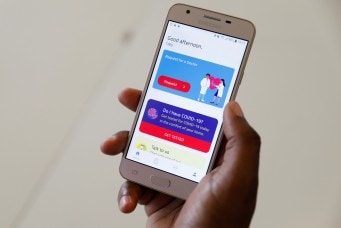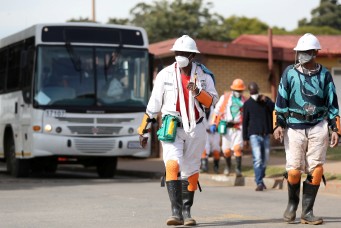South Africa latest to apply for COVID-19 aid from New Development Bank
This will mostly be used to fund medical equipment such as surgical masks, respirators, and testing supplies.

(L-R) President of South Africa, Cyril Ramaphosa, Prime Minister of India Narendra Modi, Chinese President Xi Jinping, Russian President Vladimir Putin; Brazilian President Jair Bolsonaro, attend the BRICS dome session in Brasilia, Brazil, 14 November 2019. EPA-EFE/JOEDSON ALVES
As the world prepares for partial economic collapse, watches energy markets dive, and contemplates whether a new world order will emerge in the wake of the COVID-19 pandemic, the BRICS New Development Bank (NDB) has been moving quickly to help affected countries recoup some of their financial losses.
On April 28, a video conference of the BRICS foreign ministers was convened to discuss the bloc’s response to the COVID-19 crisis, its impact on international relations, and the economies of the member states: Brazil, Russia, India, China, and South Africa. The ministers agreed to allocate $15 billion to the NDB so that it could set up a special loan instrument to support the revival of economies and help meet the emergency expenses incurred for responding to the coronavirus pandemic.
The NDB is in discussions with Brazil and South Africa for loans of $1 billion each, following an emergency loan to India for the same amount. All three loans are along similar lines to the China loan. “And we stand ready to do more, if our members request it,” said NDB President K.V. Kamath.
The BRICS nations further held discussions on ways to step up cooperation within the bloc to contain the pandemic, as well as to revive the economies once travel restrictions and lockdowns imposed in most countries to curb the spread of coronavirus have been lifted.
The proposed BRICS summit in July in St. Petersburg, Russia, may be postponed.
In March, the NDB approved a RMB 7 billion ($990 million) loan to China and then issued a RMB 5 billion ($700 million) bond in the Chinese capital market to cover that loan. At its fifth annual board meeting last week, the NDB said that it is cognizant that the spread of the COVID-19 pandemic has caused unimaginable hardship and suffering for millions of people around the globe. It noted that the governments of BRICS countries, in close partnership with multilateral fora and the international development community, have reacted proactively and pledged unprecedented fiscal and monetary stimulus packages to respond to challenges caused by the COVID-19 outbreak.
South Africa is moving quickly to try and flatten the curve while also turning to the to the NDB and other multilateral institutions such as the African Development Bank, the African Export-Import Bank, the International Monetary Fund, and the World Bank to fund some R20 billion ($1.1 billion) to purchase much-needed medical supplies.
The Health Department’s acting Director-General Anban Pillay told Parliament that South Africa had less than half the ventilators it expected to need at the peak of the COVID-19 crisis, while it needed to source around one hundred million surgical masks for healthcare workers and patients and more than ten million N95 respirators.
In his fifth address to the nation in as many weeks on April 21, South African President Cyril Ramaphosa announced a R500 billion ($27.5 billion) stimulus package that is equivalent to one tenth of the economy. Although Ramaphosa had been praised for his swift action to contain the spread of the virus with his first address on March 15, a mere ten days after the first coronavirus case had been reported in the country, the government has been criticized for its slow response on the economic side, as the national lockdown has seen a drastic reduction in economic activity.
Although the lockdown succeeded in cutting the daily increase from 243 on March 27 to only seventeen the following day, and then kept the daily increase below one hundred until April 17, there has recently been a trend upwards, and most epidemiologists expect some form of lockdown to continue until after the normal winter flu season—or in other words, until September. On April 23, the daily increase was 318 and the total case number was 3,953 with seventy-five deaths.
In his speech, Ramaphosa said the health of South Africans was his primary concern, and that that is why the first item mentioned in the breakdown of the R500 billion total was an extra allocation of R20 billion to fund the health response to fight the coronavirus. This R20 billion will also be used to source COVID-19 tests, of which more than 140,000 have been already undertaken so far. Already several firms in the automotive sector have switched from making car parts to producing ventilators.
Michael Sachs, adjunct professor at the University of the Witwatersrand and former head of the budget office in the National Treasury, said he believed that South Africa could access $20 billion from the development finance institutions.
“For me it is a no-brainer, as the finance from these institutions will be far more favorable than what South Africa can get in the international capital market,” he said in a virtual presentation at the Centre for Development and Enterprise.
He noted that the Institute for International Finance had shown that South Africa was an outlier, as its capital market had been more severely affected than other countries. Its government bond yield had increased by 160 basis points since the start of the year, and its currency had depreciated by some 25 percent.
“The cost of not financing these operations is unambiguously greater than the cost of financing, but the government faces a binding financial constraint. Responding to these imperatives means accessing external official creditors, deploying the whole public sector balance sheet, and maintaining government access to capital markets,” Sachs said.
Finance Minister Tito Mboweni, in his media presentation on April 24, said that time is of the essence—an application to the NDB for $1 billion has already been lodged, and the Treasury was busy following up.
“We will do whatever it takes to support those who need it. We will also take full advantage of this crisis to restructure the economy, but we are not in the business of printing money,” Mboweni said.
“With over $16 billion in approved projects, and roughly 150 staff compliment, I think we all agree that now is the opportune moment to uncover the full potential and might of this institution,” Mboweni said in his speech to the NDB board on April 20.
At its board meeting in December 2019, the board approved three projects aggregating to approximately $1 billion, bringing the NDB’s portfolio to fifty-two projects with loans aggregating to $14.7 billion.
Helmo Preuss is a freelance writer on economics for publications such as Alliance News, Business Day, Business Report, Grocott’s Mail, Nerve, and The BRICS Post.
Prior to that he was the chief economist at Oasis Asset Management, the economics analyst at Statistics South Africa, the economics editor at real-time financial news service I-Net Bridge, chief economist at Gencor, and an industrial engineer at Iscor.
He is currently a Ph.D. candidate in Economics at the Nelson Mandela University.
Read MoreSubscribe to Our Newsletter





